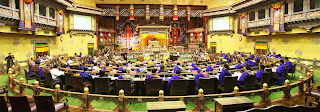Culture of Bhutan
Every country has its own culture and traditions, which have been preserved by our forefathers and even passed to today's generation. In order to show and also to prove vividly to the third countries and foreigners, primarily to show that we belong to a respective country/place. Likewise, in this article, we are also going to
see how good the Bhutanese culture is.
1. History of Bhutan
Bhutan ended her self-imposed isolation in 1961, when the Father of Modern Bhutan, the third Monarch, the late King His Majesty Jigme Dorji Wangchuk, led Bhutan on the path to modernization. Now most of you are might be wondering. Why has Bhutan been isolated before 1960's? The main reasons for Bhutan's isolation were:
I. Bhutan's rugged mountains and
II. Dense forests
These two factors not only isolated Bhutan with foreign countries but also isolated Bhutanese(natives of Bhutan) with other localities especially citizens residing within Bhutan but in a different aspects of the nation.
2. Social Organization of Bhutan
Bhutan's traditional society has been recognized as both patriarchal(system run by males, rather than females) and matriarchal(governed by females than males) and the person held on highest esteem served the family's head. However, social status also depends on a family's economic station.
3. Customs in Bhutan
 |
| Men wearing gho |
 |
| Women wearing kira |
The Kira is the national dress for women in Bhutan. It is an ankle-length dress consisting of a rectangular piece of woven fabric.
Additionally, the gho is the traditional and national dress of Bhutanese men. A knee-length robe tied with a handwoven belt, popularly known as kera. Since, gho has been noted as World biggest pocket. One of the lecturers at Sherubtse College named Ugyen Lhendup Sir, has also shared a myth with regards to gho, where he stated in the olden days, senior citizens(grandfathers) used to even carry the child inside their gho's pocket. For Bhutanese, it may not surprise them. But this myth may be yet oblivious to the foreigners.
4. Religions existing in Bhutan
The country has multiple religions such as Christianity, Hidusium and Buddhism due to existence of various people all around the country inclusive of Sharchops, Lhotshamps and Ngalops. However, Bhutan is a Buddhist country and people often refer to it as the final stronghold of Vajrayana Buddhism and the first Saint to introduce Buddhism was by the Indian Tantric Master Guru Padmasambhava in the 8th century a.k.a Guru Rimpoche.
5. Language Spoken in Bhutan
Bhutan is a multilingual country where approximately twenty languages are commonly spoken by natives of Bhutan because Bhutan has different people speaking several languages. Nevertheless, Dzongkha is the official language of Bhutan used primarily in the nation.
6. Government of Bhutan
Democratic form of government in which the party with the greatest representatives in the Parliament(legislature) forms of the government. Furthermore, National Council(NC) and National Assembly(NA) are recognized under Legislature in Bhutan where the system of law making and approval highly relies on Legislature form of government.
II. Unitary State
The Government of Bhutan has been a constitutional monarchy since 18 July 2008, where the Monarch of Bhutan is the head of state. The another form of government(Executive) power is exercised by the Lyengye Zhungtshog(Council of Ministers) headed by the Prime Minister(PM).
III. Constitutional Monarchy
It is a system of government in which a Monarch shares power with a Constitutionally organized government. Moreover, the constitution allocates the rest of the government's power to the other two types of the governments including legislative and judiciary.
7. Bhutan's Economy
Bhutan keeps strong economic and strategic relations with India, particularly as its major trading partner, source of foreign aids and as a financiers and buyer of surplus hydropower. Bhutan's small economy is based largely on hydropower, agriculture, forestry, tourism, small and cottage industries and mining which provide the livelihood for more than half of the population. Thus, these five items are also considered as Bhutan's five jewels.
8. Arts and Crafts
Around 1680, one of the eminemt Desis. The fourth Druk Desi, Gyalse Tenzin Rangye installed the school of Zorig Chusum. In total, there are 13 traditional arts and crafts(zorig chusum) in Bhutan and they are:
I. Shigzo(Carpentry)
VI. Lugzo(Bronze Coesting)
VIII. Troeko(Ornament making)
IX. Tsharzo(Cane and bamboo weaving
X. Thagzo(weaving)
XI. Tshemzo(Tailoring, Embroidery and Applique)
XII. Shagzo(Wood turning)
XIII. Dezo(Paper-making).
 |
| Source |






















Comments
Post a Comment